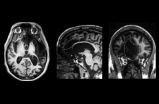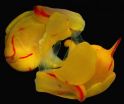(Press-News.org) Ancient Greek philosophers considered the ability to "know thyself" as the pinnacle of humanity. Now, thousands of years later, neuroscientists are trying to decipher precisely how the human brain constructs our sense of self.
Self-awareness is defined as being aware of oneself, including one's traits, feelings, and behaviors. Neuroscientists have believed that three brain regions are critical for self-awareness: the insular cortex, the anterior cingulate cortex, and the medial prefrontal cortex. However, a research team led by the University of Iowa has challenged this theory by showing that self-awareness is more a product of a diffuse patchwork of pathways in the brain – including other regions – rather than confined to specific areas.
The conclusions came from a rare opportunity to study a person with extensive brain damage to the three regions believed critical for self-awareness. The person, a 57-year-old, college-educated man known as "Patient R," passed all standard tests of self-awareness. He also displayed repeated self-recognition, both when looking in the mirror and when identifying himself in unaltered photographs taken during all periods of his life.
"What this research clearly shows is that self-awareness corresponds to a brain process that cannot be localized to a single region of the brain," said David Rudrauf, co-corresponding author of the paper, published online Aug. 22 in the journal PLOS ONE. "In all likelihood, self-awareness emerges from much more distributed interactions among networks of brain regions." The authors believe the brainstem, thalamus, and posteromedial cortices play roles in self-awareness, as has been theorized.
The researchers observed that Patient R's behaviors and communication often reflected depth and self-insight. First author Carissa Philippi, who earned her doctorate in neuroscience at the UI in 2011, conducted a detailed self-awareness interview with Patient R and said he had a deep capacity for introspection, one of humans' most evolved features of self-awareness.
"During the interview, I asked him how he would describe himself to somebody," said Philippi, now a postdoctoral research scholar at the University of Wisconsin-Madison. "He said, 'I am just a normal person with a bad memory.'"
Patient R also demonstrated self-agency, meaning the ability to perceive that an action is the consequence of one's own intention. When rating himself on personality measures collected over the course of a year, Patient R showed a stable ability to think about and perceive himself. However, his brain damage also affected his temporal lobes, causing severe amnesia that has disrupted his ability to update new memories into his "autobiographical self." Beyond this disruption, all other features of R's self-awareness remained fundamentally intact.
"Most people who meet R for the first time have no idea that anything is wrong with him," noted Rudrauf, a former assistant professor of neurology at the UI and now a research scientist at the INSERM Laboratory of Functional Imaging in France. "They see a normal-looking middle-aged man who walks, talks, listens, and acts no differently than the average person."
"According to previous research, this man should be a zombie," he added. "But as we have shown, he is certainly not one. Once you've had the chance to meet him, you immediately recognize that he is self-aware."
Patient R is a member of the UI's world-renowned Iowa Neurological Patient Registry, which was established in 1982 and has more than 500 active members with various forms of damage to one or more regions in the brain.
The researchers had begun questioning the insular cortex's role in self-awareness in a 2009 study that showed that Patient R was able to feel his own heartbeat, a process termed
"interoceptive awareness."
The UI researchers estimate that Patient R has ten percent of tissue remaining in his insula and one percent of tissue remaining in his anterior cingulate cortex. Some had seized upon the presence of tissue to question whether those regions were in fact being used for self-awareness. But neuroimaging results presented in the current study reveal that Patient R's remaining tissue is highly abnormal and largely disconnected from the rest of the brain.
"Here, we have a patient who is missing all the areas in the brain that are typically thought to be needed for self-awareness yet he remains self-aware," added co-corresponding author Justin Feinstein, who earned his doctorate at the UI in February. "Clearly, neuroscience is only beginning to understand how the human brain can generate a phenomenon as complex as self-awareness."
INFORMATION:
The research team included Daniel Tranel, UI professor of neurology and psychology and director of the Neuroscience Graduate Program; Gregory Landini, UI professor of philosophy; Antonio Damasio, professor of neuroscience at the University of Southern California; Sahib Khalsa, co-chief resident of psychiatry at the University of California Los Angeles; and Kenneth Williford, associate professor of philosophy and humanities at the University of Texas at Arlington.
The National Institute of Neurological Disorders and Stroke, the National Institute on Drug Abuse, the Mathers Foundation and the UI Carver College of Medicine funded the research.
Self-awareness in humans is more complex, diffuse than previously thought
2012-08-23
ELSE PRESS RELEASES FROM THIS DATE:
Experts say ethical dilemmas contribute to 'critical weaknesses' in FDA postmarket oversight
2012-08-23
Ethical challenges are central to persistent "critical weaknesses" in the national system for ensuring drug safety, according to a commentary by former Institute of Medicine (IOM) committee members published today in the New England Journal of Medicine.
With a caution against "reactive policymaking," committee co-chairs Ruth Faden, Ph.D., M.P.H., and Steven Goodman, M.D., M.H.S., Ph.D., with fellow committee member Michelle Mello, J.D., Ph.D., revisit the controversy over the antidiabetic drug Avandia that led to the formation of their IOM committee on monitoring drug ...
NIH uses genome sequencing to help quell bacterial outbreak in Clinical Center
2012-08-23
For six months last year, a deadly outbreak of antibiotic-resistant bacteria kept infection-control specialists at the National Institutes of Health's (NIH) Clinical Center in a state of high alert. A New York City patient carrying a multi-drug resistant strain of Klebsiella pneumoniae, a microbe frequently associated with hospital-borne infections, introduced the dangerous bacteria into the 243-bed research hospital while participating in a clinical study in the summer of 2011.
Despite enhanced infection-control practices, including patient isolation, the K. pneumoniae ...
Study suggests early exposure to antibiotics may impact development, obesity
2012-08-23
NEW YORK, August 22, 2012 – Researchers at NYU School of Medicine have made a novel discovery that could have widespread clinical implications, potentially affecting everything from nutrient metabolism to obesity in children.
Since the 1950's, low dose antibiotics have been widely used as growth promoters in the agricultural industry. For decades, livestock growers have employed subtherapeutic antibiotic therapy (STAT), not to fight infection or disease, but to increase weight gain in cattle, swine, sheep, chickens and turkey, among other farm animals.
First author ...
Sky-high methane mystery closer to being solved, UCI researchers say
2012-08-23
Irvine, Calif. – Increased capture of natural gas from oil fields probably accounts for up to 70 percent of the dramatic leveling off seen in atmospheric methane at the end of the 20th century, according to new UC Irvine research being published Thursday, Aug. 23, in the journal Nature.
"We can now say with confidence that, based on our data, the trend is largely a result of changes in fossil fuel use," said chemistry professor Donald Blake, senior author on the paper.
Methane has 20 times the global warming potential of carbon dioxide, although CO2 is filling the ...
Low-dose sedative alleviates autistic-like behavior in mice with Dravet syndrome mutation
2012-08-23
A low dose of the sedative clonazepam alleviated autistic-like behavior in mice with a mutation that causes Dravet syndrome in humans, University of Washington researchers have shown.
Dravet syndrome is an infant seizure disorder accompanied by developmental delays and behavioral symptoms that include autistic features. It usually originates spontaneously from a gene mutation in an affected child not found in either parent.
Studies of mice with a similar gene mutation are revealing the overly excited brain circuits behind the autistic traits and cognitive impairments ...
Scientists reveal how river blindness worm thrives
2012-08-23
Scientists at the University of Liverpool have found that the worm which causes River Blindness survives by using a bacterium to provide energy, as well as help 'trick' the body's immune system into thinking it is fighting a different kind of infection.
River Blindness affects 37 million people, mainly in sub-Saharan Africa, causing intense itching of the skin, visual impairment and in severe cases, irreversible blindness. It is caused by a parasitic worm that is transmitted by blood-feeding blackflies, which breed in fast-flowing rivers.
The team at Liverpool investigated ...
New climate history adds to understanding of recent Antarctic Peninsula warming
2012-08-23
Results published this week by a team of polar scientists from Britain, Australia and France adds a new dimension to our understanding of Antarctic Peninsula climate change and the likely causes of the break-up of its ice shelves.
The first comprehensive reconstruction of a 15,000 year climate history from an ice core collected from James Ross Island in the Antarctic Peninsula region is reported this week in the journal Nature. The scientists reveal that the rapid warming of this region over the last 100 -years has been unprecedented and came on top of a slower natural ...
Future memory
2012-08-23
A new class of organic materials developed at Northwestern University boasts a very attractive but elusive property: ferroelectricity. The crystalline materials also have a great memory, which could be very useful in computer and cellphone memory applications, including cloud computing.
A team of organic chemists discovered they could create very long crystals with desirable properties using just two small organic molecules that are extremely attracted to each other. The attraction between the two molecules causes them to self assemble into an ordered network -- order ...
Traumatic mating may offer fitness benefits for female sea slugs
2012-08-23
Female sea slugs mate more frequently than required to produce offspring, despite the highly traumatic and biologically costly nature of their copulation, as reported Aug. 22 in the open access journal PLOS ONE.
The authors of the study, led by Rolanda Lange of the University of Tuebingen in Germany, investigated the mating behavior of a simultaneously hermaphroditic species of sea slug that mates via an extravagant ritual that involves a syringe-like penile appendage that stabs the partner to inject prostate fluids and sperm.
Surprisingly, the researchers found that ...
Managerial role associated with more automatic decision-making
2012-08-23
Managers and non-managers show distinctly different brain activation patterns when making decisions, according to research published Aug. 22 in the open access journal PLOS ONE.
The authors of the study, led by Svenja Caspers of the Institute of Neuroscience and Medicine, Research Centre Jülich in Germany, used functional MR imaging to track the decision making process for managers and non-managers. Subjects were required to perform equally repetitive decisions, one form of decision making occurring in every-day work life. The authors found that manager and non-managers ...


